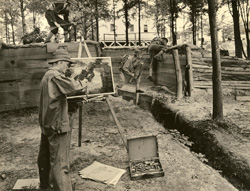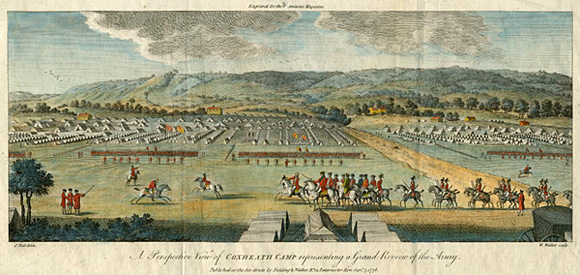Preparing for War: Maneuvers, Mock Battles and Sham-Fight.
After all, your Holiday-Camps, as it seems those are called, which are productive of no bloodshed, are pleasant, are enlivening things.
— Westminster Magazine, August 1778
Ever since armies first gathered to conquer and defend, soldiers have practiced their art to hone their martial skills in preparation for war. In medieval Europe, the tournament jousts while entertaining served the more important function of preparing the riders for the charge with lance, shield and sword, and many castles were equipped with tilt yards for practicing such drills. In an age when the bow supplied the main projectile on the battlefield, archery butts were a frequent sight in most villages. As warfare became more formalized in the early modern period, training regimens were required of every able-bodied man. The Swedish armies of Gustavus Adolphus in the 17th century drilled meticulously in the art of marching, forming for battle, firing in ranks, and coordinating musket, pike, and lance into a unified fighting machine. They may have practiced for battlefield conditions but the idea of staging a mock battle using soldiers from the same side, known as a sham-fight, was still a century or two away.
For artists, soldiers and soldiering offered a certain attraction, and while the representation of actual battle was difficult to achieve, there were many opportunities to observe the military in more peaceful pursuits. So for every battle scene that was painted, there were many more images of soldiers drilling or off-duty. With the development of "war games" in the 18th century, the opportunity arose for artists to convey an idea of warfare first-hand, albeit staged and controlled, without fear of being injured. Mock battles removed the threat of real violence making it safe for artists to sketch the proceedings of soldiers going through the motions of combat. The Prussian army of Frederick the Great carried out maneuvers whereby units "fought" against each other, all the while watched by intrigued civilians, writers and artists. Prussia created the standard by which other European armies measured themselves, including the British, soon to be mired in the debacle of the American Revolution. At the same time, fear of invasion from France was very real and a number of training camps were established in southern England to allow raw militia and regular troops to train for what seemed an inevitable clash.
The Westminster Magazine covered the events at one such camp held at Coxheath, near Maidstone, Kent, during the summers of 1778 and 1779. By all accounts, this camp was on a massive scale involving 17,000 troops as well as civilians, many representing the 700 retailers who had come from London to service the soldiers. The paper quoted a letter from an officer of militia in August 1778 to his friend: "We are frequently marched out in considerable bodies to the heaths or commons adjacent, escorted by the Artillery, where we go through the various movements, maneuvers and firings of a field of battles. In these expeditions, let me assure you, there is much fatigue, and no little danger…the most grand and beautiful imitations of action are daily presented to us; and, believe me, the army in general are becoming enamored of war, from the specimens they have seen of it."
Watching the proceedings was the celebrated Alsatian-born artist, scene painter, and creator of realistic pageants, Phillipe Jacques de Loutherbourg, who had had some successes staging theatrical reenactments of real-life events. Using sketches made on site, the artist was able to create a simulation as a back-drop for a two-act entertainment written by the renowned playwright, Richard Sheridan, entitled The Camp which premiered in October 1778 and performed on 56 successive occasions. This brought increased attention on de Loutherbourg and an important commission, possibly from the king himself, to paint another military camp, this one at Warley Common, Essex. Like Coxheath, Warley attracted its fair share of society and celebrities including the great travel writer and lexicographer, Dr. Samuel Johnson, who was not present however, when a grand review was held on October 19th 1778, before George III. The following day, the king accompanied by Queen Charlotte, proceeded to the common where he reviewed the troops of horseback, and she, seated on a specially constructed stand, observed a mock battle. The London Gazette described what happened next:
The line then went through their several firings, after which the light Infantry and
grenadiers, with the artillery, marched immediately through the woods towards Little
Warley (followed by the whole line in two columns,) where, as well as in the adjacent
woods, several batteries were placed, and many manoeuvres of attack and defence
were performed, with a continued fire of musquetry and cannon, to which the
situation and variety of the ground were very favourable, and afforded much pleasure
to the numerous spectators. The operations concluded shortly before 3 p.m.

Loutherbourg was able to sketch some of the scenes and delineated in fine pencil drawings members of the various units participating. No doubt he was privy to the complaints expressed by the soldiers that there was not enough food to go around! The fruits of his endeavors were displayed in two large oil paintings exhibited at the Royal Academy in 1779 and 1780 respectively, depicting the review of the 19th, and the mock battle of October 20th.
A century later, the Prussians were still achieving remarkable military success with their trilogy of victories over Denmark, Austria and France in the wars of German unification between 1864 and 1871. Other nations took careful note and sent military attaches to observe the Germans training and implement some of their methodologies. Again, the British general staff was paying close attention and as early as the fall of 1871, the British army conducted a series of maneuvers involving a series of sham battles ranging over the heathlands of Surrey and Hampshire. Viewing these exercises were foreign military observers along with a host of journalists including the ex-patriot British military artist, Orlando Norie. He had traveled from his home in Dunkirk, France, to record the activities for the fine-art publisher, Arthur Ackerman. In the following year, the army held similar maneuvers and again Norie was present. His pictures of the events went on exhibition at Ackermans at the beginning of 1873 and were described as follows:
A series of drawings of the highest interest and merit, representing the various
manoeuvres of the several regiments, in mimic war, at Aldershot and places adjacent,
during the autumns of the two past years. In number there are about a hundred; forty
of which are finished drawings, some of large size, the reminder being sketches. They
are the productions of Mr. Orlando Norie; it is not too much to say that military
drawings so excellent have never been produced either in England or in France…

The post-mortem into the failure of the French army in 1870-71 revealed many shortfalls and its general staff began to make amends by developing new tactics. Surprisingly, the French artists began to take an increasing interest in their army’s role during the recent war which bordered on an obsession, and began to paint numerous scenes of heroic stands, dramatic incidents, and moments away from battle. In fact, it has been said that their artists won on canvas what the army failed to win in the field. Side by side with the war scenes were other military pictures depicting the army, and reputable artists such as Edouard Detaille, produced many images of training and maneuvers. From a young age, he had been exposed to the military and he stated that "I never missed a review, and during my holidays it was my delight to be present at the manoeuvers of regiments, and to go to listen to the trumpets in the forest of St. German." In 1865, as an impressionable 17-year old, he witnessed the grand maneuvers at the camp of Châlons where "I had the honor, and I was not a little proud of it, when talking to my comrades, of sleeping in the same tent with Colonel Corot of the Second Cuirassiers." Detaille himself, had seen war first-hand as a soldier in the Garde Mobile during the German war, and afterwards was a sub-lieutenant in the reserve. As such, he took part in the grand maneuvers of the 3rd Army Corps on the plains of the River Eure around Dreux, and a number of his paintings and sketches of his experiences appeared in Les Grandes Manoeuvres published in 1884.

By the 20th century, maneuvers and war games were common training methods for simulating battlefield conditions but the subject held little attraction for artists. This would change dramatically during the Second World War when thousands of artists found themselves called up into the armed forces, especially in the United States. This was their first taste of military life and many began to record their new experiences on paper. One such artist was Dwight Shepler who later recorded the practice landings with live ammunition at Slapton Sands on the coast of Devon, England, in preparation for D-Day.

